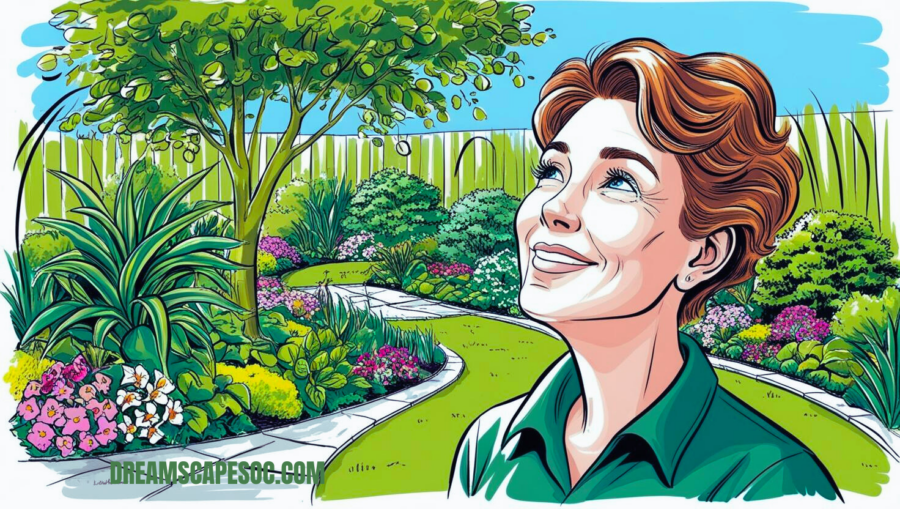Knowing the Differences Between Shade Types
- Spots of light and shadow are produced as sunlight filters through tree branches or other objects, a phenomenon known as dappled shade. Since it simulates the lighting seen in a forest, it is perfect for a wide range of plants.
- Partial Shade: Only a few hours of sunlight per day, typically in the morning or late afternoon, reach places that experience partial shade. When it comes to plant selection, this shade type offers you a little more freedom because certain sun-loving plants can still thrive here.
- Full Shade: Full shade areas get little to no direct sunlight, making them perfect for hardy shade-loving plants. These spaces are typically under dense trees or alongside tall buildings and can be a great opportunity to create a lush, green retreat.
Elevate Your Outdoor Space—Explore Exclusive Landscaping Concepts
Picking the Right Shade-Loving Plants
You have many choices when it comes to plants that prefer shade. To create visual appeal in your garden, mix ground coverings, foliage plants, and flowering plants to offer depth, color, and texture.
- Blooming vegetation: Some lovely blooms can be enjoyed even in the shade. Astilbes’ fluffy, multicolored plumes make them ideal for shady gardens. The tiny, heart-shaped flowers of bleeding hearts add a romantic touch, while Hellebores, often called Lenten Roses, provide you with early blooms that cheer you up in the late winter or early spring.
- The foundation of every shadow garden are foliage plants, which offer year-round color and structure. With its large, eye-catching leaves that come in a range of sizes and hues, hostas are a timeless option. The soft, feathery texture of ferns gives the impression of a woods, while the vivid colors of Heucheras (also known as Coral Bells)—which range from deep purple to vivid green—stand out brilliantly in the shadow.
- Ground Covers: For filling in gaps and creating a lush, carpeted effect, ground covers are ideal. Pachysandra is an evergreen option that does well in full shade and spreads quickly. Lamium, with its silvery foliage and small flowers, adds brightness to darker corners, while Sweet Woodruff offers star-shaped flowers and a pleasant fragrance.
| Shade Garden Idea | Details |
| Layered Planting | Use tall, medium, and low plants together. |
| Dappled Shade Plants | Choose Astilbe or Bleeding Heart. |
| Pathways | Add stone or gravel paths lined with ferns. |
| Water Features | Incorporate small fountains or birdbaths. |
| Lighting | Use solar lights or lanterns for ambiance. |
| Foliage Variety | Mix textures with ferns, Hostas, and Heucheras. |
| Ground Covers | Try Pachysandra or Lamium. |
| Native Plants | Select shade-loving natives for low maintenance. |
| Seating | Place a weatherproof bench in a cozy spot. |
| Decor | Add statues or colorful pots for charm. |
The main takeaway is that shade gardens are a special way to add rich beauty to your outdoor area. You can create a tranquil, visually appealing haven in shaded regions with the correct plant selections and design concepts.
Transform Your Outdoor Space Today – Download Your Free Landscaping and Gardening Checklist
Fun Design Ideas for a Shade Garden
Designing a shade garden is all about layering plants and creating a harmonious look. Here are some ideas to help bring your shade garden to life.
- Layered Planting: For a tiered design that adds depth and intrigue, try layering plants of varying heights. Start with low-growing ground covers, then add medium-height plants like Hostas, and conclude with towering plants like ferns or tiny trees for your backdrop. Your landscape will appear full and lush with this arrangement, which highlights every layer.
- Pathways and Borders: Adding a pathway through your shade garden can invite exploration and add structure. Use natural materials like stepping stones or gravel to create a path, and line it with low plants like ferns or Pachysandra to give it a defined, cohesive look.
- Water Features and Focal Points: A water feature like a small fountain or birdbath can enhance the relaxing vibe of your shade garden. If water isn’t your style, consider a decorative focal point like a statue, stone lantern, or rustic bench to give the space personality and draw attention to specific areas.
Simple Tips for Shade Garden Maintenance
- Soil Quality: Shade gardens can sometimes have dry soil, especially if they’re under large trees that absorb a lot of water. Enhance your soil by mixing in organic matter such as compost or peat moss. This boosts moisture retention and nutrients. Plus, spreading a layer of mulch around your plants keeps moisture in and stops soil erosion.
- Moisture Management: Shade plants thrive on consistent moisture, but be careful not to overwater, as it can cause root rot. Water early in the day so the soil can absorb the moisture without staying damp overnight. A drip irrigation system can be a good option to give your plants steady moisture without oversaturating the ground.
- Pruning and Trimming: Keep your plants well-spaced and healthy by pruning regularly to encourage airflow and prevent overcrowding. If there are tree branches casting too much shade, consider trimming them back to allow a bit more light for plants that thrive in partial shade.

Adding Accessories and Decor to Your Shade Garden
Accessorizing your shade garden can make it feel even more inviting and give you a space to relax and enjoy.
- Outdoor Furniture: Choose weather-resistant materials like treated wood, stone, or metal for furniture that can handle the humidity often found in shaded areas. Place a bench or chair in a spot that offers a view of the garden’s focal points so you have a cozy place to unwind.
- Lighting: Lighting can really enhance your shade garden, especially for evening enjoyment. Solar lights, string lights, and lanterns add a cozy vibe and can beautifully illuminate paths or showcase certain plants, turning your garden into a magical space at night.
- Accent Pieces: To add unique touches, use garden accent pieces like hanging pots for shade-loving ferns, trellises for climbing plants, or statues that go well with your garden’s design. Pots or containers with natural tones can provide more splashes of color and intrigue without taking over the space.
Use native plants that grow well in shaded locations as a quick tip. Your garden will look more localized and require less upkeep thanks to them.
Wrapping It Up
An excellent method to turn dim spaces into a lush, welcoming spot where you can unwind and commune with nature is to create a shade garden. You can make your shade garden a favorite location in your yard with the correct plants, some imaginative design ideas, and a little maintenance. Savor the tranquil atmosphere of shady spots and recognize the unique charm they bring to your landscape.
FAQs
What are some good plants for a shade garden?
Great plants for a shade garden include Hostas, ferns, and Hellebores. For ground cover, Pachysandra and Lamium work well in low-light conditions.
How can I improve the soil in my shade garden?
To boost soil quality, add organic matter such as compost, peat moss, or leaf mulch. This enriches the soil, helping it retain moisture and nutrients that shade-loving plants need.
Can I grow vegetables in a shade garden?
Leafy greens like Swiss chard, spinach, and lettuce may withstand some shadow, but most veggies need full light. Partial shade is ideal for root vegetables like beets and carrots.
What type of mulch should I use in a shade garden?
Organic mulches like bark chips, pine needles, and leaf mold work well in shade gardens. They help with moisture retention, weed suppression, and soil improvement.
How can I attract wildlife to my shade garden?
Add a water supply, dense ground cover, and native plants to your shadow garden to make it more wildlife-friendly. The natural aspect of the garden is enhanced by these features, which attract insects, birds, and small animals.

